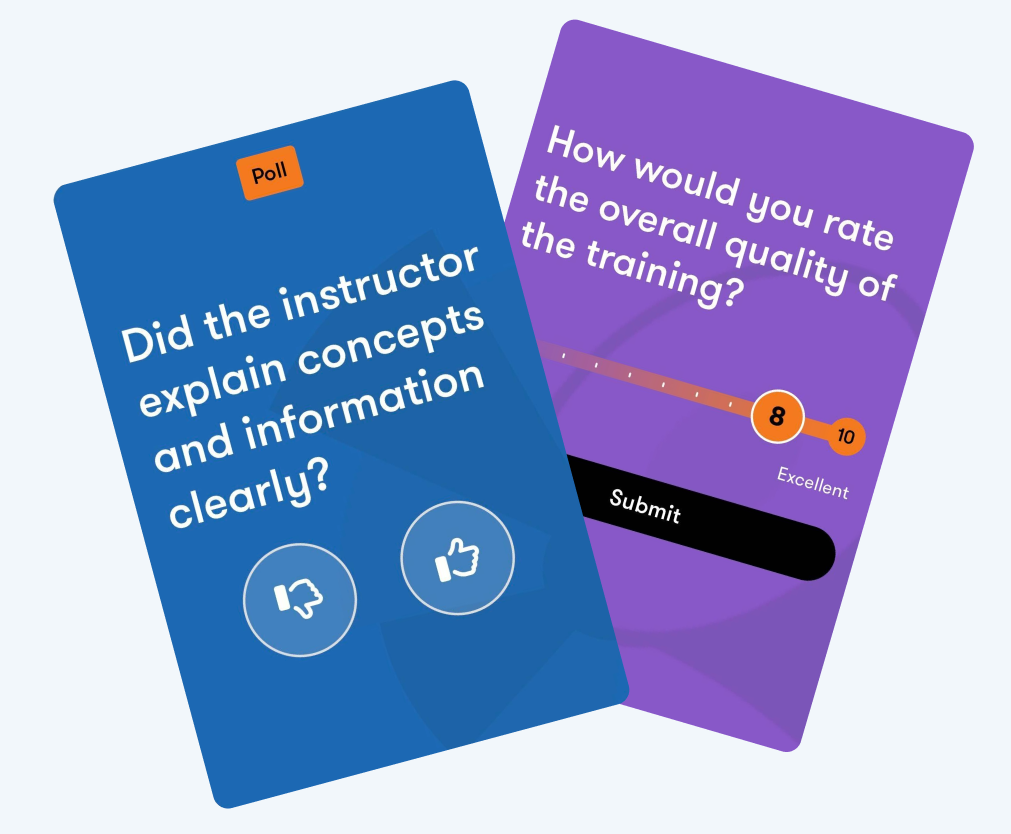You know the value of having a high-quality training program for your employees. Investing in their learning and development leads to greater outcomes for them and your business. Yet, there is often an important step in the learning process that’s overlooked, the post training survey.
In any learning environment, reflection is an important part of the process. Sharing well-thought-out training survey questions will help your staff reflect on their learning and in turn help your organization reflect on its training.
In this post, we’ll explore what a post training survey is, why you need one, different types of training survey questions and responses, and of course plenty of example questions to get you started.
What are training survey questions in an employee post training survey?
A post training survey is a survey given to employees after they finish a training program. It gathers important information through intentional training survey questions. The goal is to improve the training program.
Post-training survey questions gather employee feedback so the organization knows what’s working, and what can be improved. Using this feedback you can make adjustments in real time. Organizations can also measure how effective the training is. By listening to employees’ thoughts and opinions you’ll improve your training programs, resulting in a better prepared staff.
Why you need a quality post training survey
A post-training survey is necessary for several reasons. First, it allows you to measure the effectiveness of your training program. By gathering feedback from employees who have completed the training, you can assess how well the training has impacted both the learners, and therefore gain understanding of its initial impact on the business as a whole.
Gain valuable insights on how to improve future training programs
By analyzing the feedback, you can identify areas that may need improvement or clarification. This helps ensure that future training sessions address any potential gaps, making them more effective.
Know if employees completed the training and understood its content
This feedback is crucial in evaluating the training program’s overall success. With it, you can identify potential barriers to comprehension or engagement with the material. If learners respond that the training was difficult to understand, you can follow up and ask which specific areas were unclear so that you know where to make improvements.
Participants share their honest and unbiased opinions
Remember that you can make your training evaluation form anonymous. When asking a simple question like, “How was training?” you’ll likely receive a canned answer. A survey enables you to create an environment where employees feel comfortable expressing their thoughts. This creates open communication and a culture of continuous improvement.
Determine the type of training that is most suitable for your employees
The only way to know your employees’ needs and preferences is by asking the right questions. In doing this, you can tailor future training programs to better meet their expectations. This improves engagement and participation.
Gauge the level of engagement and satisfaction among employees
By measuring their satisfaction, you can identify areas where the training excelled and areas to adjust. This information is instrumental in creating a positive learning experience while maintaining high levels of employee satisfaction and engagement.
Assess the competency of your instructors
By gathering feedback on their teaching methods, clarity, and effectiveness, you can identify areas for improvement in their delivery. This ensures that your instructors are equipped with the necessary skills to deliver high-quality training experiences.
Compare skills before and after the training
By evaluating employees’ progress, you can determine the training’s impact on their knowledge. This information is valuable in measuring the return on investment (ROI) of the training program and showcasing its value to the organization.
By asking quality training survey questions you can continuously enhance your training programs and provide valuable learning experiences to your employees.
Getting the most out of your responses
To get the most out of your training survey responses you need to ask the right questions. In the 1950s, Dr. Donald L. Kirkpatrick introduced the concept of post training surveys. With decades of use, The Kirkpatrick Model, or the four levels of training evaluation, has been applied in all work sectors. It has become the gold standard for evaluating the effectiveness of training programs.
Knowing the purpose of each question will help you write meaningful ones. Here are the four levels:
Level 1: Reaction
This level collects the reaction from the learners. It aims to uncover their opinions on the training’s learning environment, the learning experience, and its potential usefulness in their work.
Level 2: Learning
Level 2 evaluations focus on assessing the actual learning outcomes of participants. If level two evaluations indicate that learning did not occur effectively in a specific training course, the level one survey can provide insights into this. This information is valuable as it helps identify the specific areas that require improvement. You can then enhance the training program accordingly.
Level 3: Behavior
Level three evaluates how well the learner applies what they’ve learned when they return to their job. During this time you’ll gain insights into the effectiveness of the training program. This time also provides the opportunity to recognize and reinforce positive behaviors and practices resulting from the training. If there are learning gaps refer back to responses from levels one and two.
Level 4: Results
Level four gauges the tangible impact of the training program on key performance indicators, productivity, efficiency, quality, customer satisfaction, or any other targeted outcomes.
Types of training survey questions
When writing training survey questions for employees there are a few things to keep in mind. First are the two types of questions you’ll ask: subjective and objective. Next are the training goals and expectations.
Subjective questions
These are questions that elicit thoughts and feelings. Because the answers are opinion based, the responses are not easy to verify. An example of a subjective question is, “Did the quality of the content meet your expectations?”
Objective questions
These questions are fact-based with verifiable answers. An example would be, “Did you complete the training session?”
Training goals and expectations
Considering the goals and expectations of the company and the employee will guide you toward writing better post training survey questions. Ask yourself:
- What are the expectations of the training from the company’s perspective?
- What are the training goals?
- What are the post training evaluation goals?
As with any aspect of your training and development program, consider your company’s unique needs when writing survey questions. Start with some of the sample training survey questions below, and then tailor them to your needs.
Create and share mobile training surveys in minutes

Types of training survey responses
As with questions, there are various forms of responses you can elicit after training. This will help collect qualitative and quantitative data. Here are some of the types of responses you can include.
Multiple choice: These responses provide participants with one or more options to choose from. Multiple-choice questions allow for easy data analysis and quantitative responses.
Likert scale: Likert scale responses involve participants rating their agreement or disagreement with a statement on a scale. Typically the range is from strongly agree to strongly disagree. This type of response shows the intensity of the response.
Open-ended text: Open-ended text responses allow participants to provide detailed written feedback in their own words. They can express thoughts, suggestions, or concerns related to the training program. Qualitative insights can be found here.
Rating scales: These allow participants to rate various aspects of the training program using a numerical scale. For example, participants may rate the overall quality of the training or the relevance of the content.
Yes/No responses: Here, participants indicate their agreement or disagreement with a specific statement or question. This type of response offers a straightforward way to gather quick feedback.
Ranking: Ranking responses involve participants ordering a list of items based on their perceived importance, relevance, or effectiveness. This type of response allows participants to prioritize aspects of the training program.
Once you have written your survey questions it is recommended that you test them with a small group. This will help identify any questions that need to be revised for clarity.
30 sample training survey questions
Starting out you might be asking — What training questions should be included in the training survey? Here are some sample training survey questions to get you started.
Overall training experience
- How would you rate the overall quality of the training?
- Did the training meet your expectations?
- Did you learn something new from the training you completed?
- How satisfied are you with the training content and materials?
- Was the training at a comfortable pace? If not, was it too fast or too slow?
Learning outcomes
- To what extent do you feel the training improved your knowledge and skills?
- Can you provide examples of how you have applied what you learned in your job?
- How confident are you in your ability to apply the newly acquired knowledge and skills?
Training effectiveness
- Did the training program address your learning needs and objectives?
- Were the training methods engaging?
- Were the learning activities interactive?
- Did the training materials and resources support your learning?
Instructor evaluation
- How would you rate the instructor’s knowledge and expertise in the subject matter?
- Did the instructor explain concepts and information clearly?
- Did the instructor encourage active participation and provide opportunities for discussion?
- Did the instructor answer questions clearly and effectively?
- Did the instructor provide you with specific examples of how to
Relevance and applicability
- To what extent do you feel the training content was relevant to your job role?
- Did the training program address specific challenges in your work?
- How likely are you to use the skills and knowledge gained from the training in your daily work?
Training support and resources
- Were the training materials helpful in supporting your learning?
- Did you receive sufficient support and guidance during the training program?
- Were there any challenges that hindered your learning experience?
- Did the instructor provide you with materials you can reference back to at a later date?
Impact on performance
- Have you noticed any improvements in your performance since the training?
- Have you received any positive feedback regarding your performance after the training?
- How has the training helped you meet job expectations or goals?
Suggestions for improvement
- What part of the training can be improved?
- Are there any additional topics you want to see covered in future training?
- What suggestions do you have on how to improve the delivery or effectiveness of the training?
Gather feedback from your employees, without interrupting the work day.

FAQs
What are 5 good survey questions?
- How would you rate the overall quality of the training?
- To what extent do you feel the training improved your knowledge and skills?
- How would you rate the instructor’s knowledge and expertise in the subject matter?
- Did the training program address specific challenges in your work?
- What part of the training can be improved?
Why should you conduct post training surveys?
Post training surveys collect valuable feedback from training participants. They help you know how effective training was. Using surveys you can make data-driven decisions to optimize your training.
What types of training survey questions should be included in a survey?
In a post-training survey, you ask qualitative and quantitative questions. You may provide options to choose from, ask for ratings, or let people write their thoughts. The questions cover things like how the training was, what was learned, if it was useful, and how the instructors did. You might also ask the participant’s opinion on the training.
How can post training surveys help our organization?
When asking the right questions you’ll gain insight directly from your team as to what’s working and what’s not with your training. Post training surveys create a culture of sharing and openness within your organization. Your surveys can also help ensure that your training is matching your goals.
A few short questions go a long way in improving your training program
A healthy training program needs several components that work together. It must be tailored to your business’s specific needs, and it must evolve as these needs change. The best place to start when it comes to determining how your program should evolve is with feedback from the people who have already gone through it. Remember, your post training survey doesn’t need to be a long succession of questions. Even a handful of tailored questions can go a long way in getting you valuable feedback.
Key takeaways
- Training survey questions help improve training programs. By gathering feedback from employees, you can determine the training’s effectiveness. At the same time, any adjustments needed will surface. By asking the right questions, you’ll gauge employee engagement and satisfaction.
- Post training surveys allow for reflection by both the employee and the organization. Well thought out questions can remove communication barriers and gather unbiased opinions.
- Using varied training survey questions and response types improves the survey’s effectiveness. Subjective questions capture thoughts and feelings while objective questions provide factual responses. Response formats such as multiple choice, Likert scale ratings, open-ended text, rating scales, yes/no responses, and rankings offer flexibility in gathering qualitative and quantitative data.


